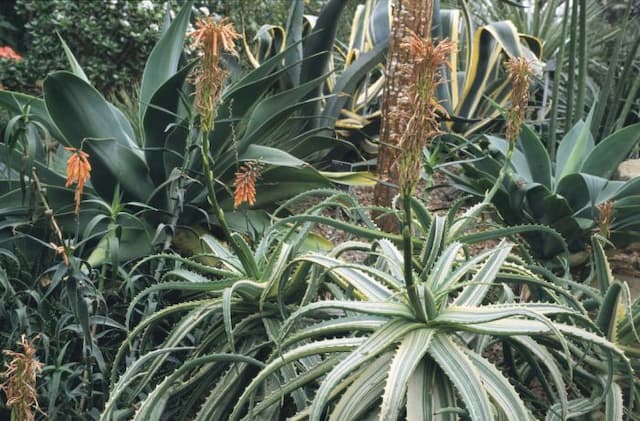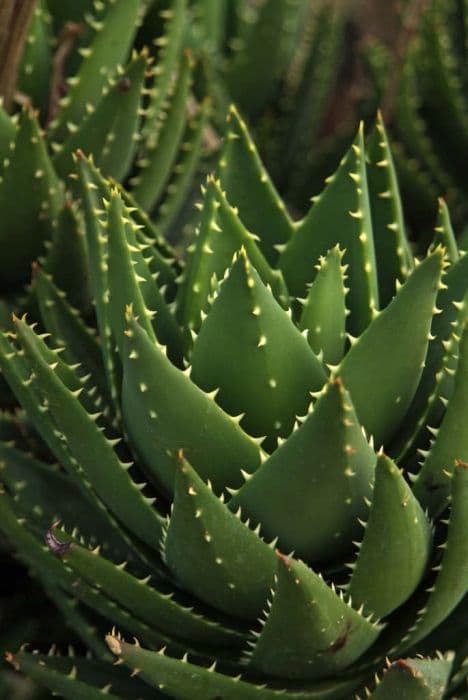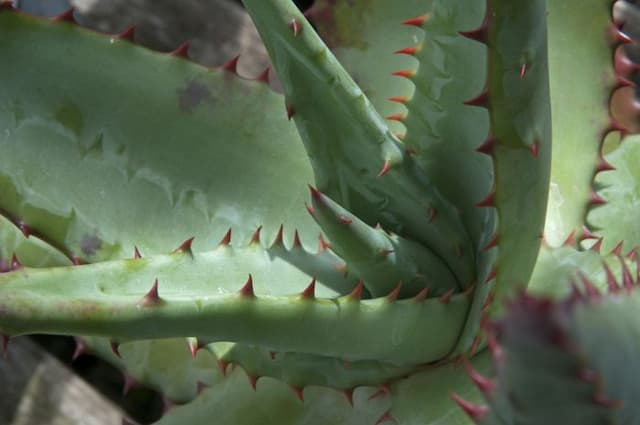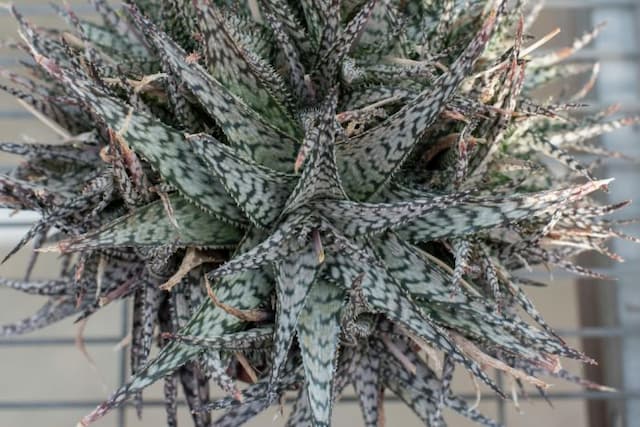Lawyer's Tongue Gasteria bicolor var. liliputana

ABOUT
The plant known as Gasteria bicolor var. liliputana is a small, succulent with a distinct appearance. Its thick, tongue-shaped leaves are a striking combination of green and white, and they have a rough, warty texture that adds to the visual interest. The leaves are arranged in a spiral form, which emanates from the center of the plant, creating an attractive rosette pattern. Each leaf displays an array of white spots or stripes that contrast nicely with the deeper green background color. Over time, as the plant matures, it may produce offsets that cluster around the base of the mother plant, giving it a fuller, more robust look. The edges of the leaves are often lined with a subtle keel, adding further texture to its already intriguing silhouette. During its bloom season, the plant may produce tubular, pendulous flowers, but these are typically not the main attraction when compared to the decorative leaves. Overall, this plant is admired for its compact form and ornamental foliage that can provide an exotic touch to any collection or as a standalone display.
About this plant
 Names
NamesFamily
Asphodelaceae
Synonyms
Lilliput Gasteria, Dwarf Gasteria
Common names
Gasteria liliputana, Gasteria bicolor var. lilliputana
 Toxicity
ToxicityTo humans
Gasteria bicolor var. liliputana, commonly known as Ox Tongue, is generally considered non-toxic to humans. However, as with many houseplants, it is not intended for consumption. Accidental ingestion might lead to mild gastrointestinal discomfort due to the plant's saponins and anthraquinones. It is always advisable to keep plants out of the reach of children to prevent any potential issues.
To pets
Ox Tongue is not known to be toxic to pets such as cats and dogs. If a pet were to ingest a part of the plant, they may experience mild gastrointestinal upset as their digestive systems are not designed to process plant materials well. Symptoms might include vomiting or diarrhea, but serious complications are unlikely. Nonetheless, it is always best to prevent your pets from eating plants.
 Characteristics
CharacteristicsLife cycle
Perennials
Foliage type
Evergreen
Color of leaves
Green
Flower color
Pink
Height
4 inches (10 cm)
Spread
6 inches (15 cm)
Plant type
Succulent
Hardiness zones
9
Native area
South Africa
Benefits
 General Benefits
General Benefits- Low Maintenance: Gasteria 'Little Warty' requires minimal care, making it ideal for busy individuals or those new to gardening.
- Drought Tolerant: It is exceptionally tolerant to drought conditions due to its succulent nature, requiring infrequent watering.
- Attractive Appearance: With its unique texture and form, 'Little Warty' adds an aesthetical appeal to any setting.
- Small Size: Its compact size makes it perfect for small spaces such as apartments and office desks.
- Non-Toxic: 'Little Warty' is generally considered non-toxic, making it safe to keep around pets and children.
- Easy to Propagate: It can be easily propagated from leaf cuttings or offsets, making it simple to create more plants.
- Versatile: It can be grown in a variety of containers and settings, from terrariums to outdoor rockeries in suitable climates.
 Medical Properties
Medical PropertiesThis plant is not used for medical purposes.
 Air-purifying Qualities
Air-purifying QualitiesThis plant is not specifically known for air purifying qualities.
 Other Uses
Other Uses- Miniature Gardening: Gasteria liliputana is ideal for miniature gardening or fairy gardens due to its small size, providing an interesting texture and form.
- Education: This plant can be used in educational settings to teach children and enthusiasts about succulent care and plant propagation methods.
- Photography Subjects: Their unique appearance makes them a fascinating subject for macro photography enthusiasts.
- Artistic Inspiration: Artists may use Gasteria liliputana as a model for drawing, painting, or digital art, capturing its intricate patterns and structures.
- Desk Ornament: It can serve as a living desk ornament, adding greenery to a workspace without taking up much space.
- Gifts: Due to their ease of care and small size, they make thoughtful gifts for plant lovers, especially as a housewarming present.
- Bonsai Companions: They can be placed alongside bonsai trees to complement the overall display with contrasting foliage.
- Therapeutic Horticulture: Gasteria liliputana is used in therapeutic horticulture programs, aiding in relaxation and stress reduction.
- Wedding Favors: These small succulents can be potted and given as eco-friendly and lasting wedding favors.
- Stop Action Animation: Their slow growth and interesting shapes make them suitable for use in stop action animation projects as a dynamic element.
Interesting Facts
 Feng Shui
Feng ShuiThe Ox Tongue plant is not used in Feng Shui practice.
 Zodiac Sign Compitability
Zodiac Sign CompitabilityThe Ox Tongue plant is not used in astrology practice.
 Plant Symbolism
Plant Symbolism- Resilience: Gasteria bicolor var. liliputana, commonly known as "Little Warty," is a succulent that can tolerate periods of drought. This characteristic symbolizes an ability to endure and thrive in challenging conditions.
- Protection: With its thick, warty leaves, "Little Warty" is often seen as a symbol of protection, guarding against negative influences much like its robust foliage protects the plant's inner water reserves.
- Persistence: This plant's slow but steady growth is a symbol of persistence and the idea that patience and perseverance can lead to gradual success.
- Uniqueness: The unique, bumpy texture and patterning of the leaves represent individuality and the beauty of standing out from the crowd.
 Water
WaterGasteria, commonly known as "Lawyer's Tongue," should be watered sparingly, as it is a succulent that prefers a dry climate. Generally, watering once every two to three weeks is sufficient, allowing the soil to dry out completely between waterings. When you do water, do so thoroughly, providing enough water so that it runs out of the drainage holes at the bottom of the pot. Avoid watering little and often, as this can promote root rot. Depending on the size of the pot, you might use around 4 to 6 ounces of water each time for a small pot during the active growing season.
 Light
LightLawyer's Tongue thrives best in bright, indirect sunlight. It should be placed in a spot where it can get plenty of light but is shielded from the harsh rays of direct midday sun. A north-facing window or a position that receives filtered light through a sheer curtain would be ideal for maintaining the vibrant color and health of the plant.
 Temperature
TemperatureLawyer's Tongue prefers a warm climate with temperatures ranging between 50 and 80 degrees Fahrenheit. It should not be exposed to temperatures below 40 degrees Fahrenheit as cold weather can damage the plant. The ideal temperature range for this Gasteria is around 65 to 75 degrees Fahrenheit, which encourages healthy growth and flourishing.
 Pruning
PruningLawyer's Tongue rarely needs pruning. Occasionally, you may remove dead or damaged leaves to keep the plant looking tidy and to encourage good air circulation. The best time for pruning is in the spring or early summer when the plant is in its active growing phase. Pruning is typically done for aesthetic reasons and to remove any unwanted pups if you wish to control the spread of the plant.
 Cleaning
CleaningAs needed
 Soil
SoilThe Gasteria, commonly known as Ox Tongue, thrives in well-draining, gritty soil with a pH between 6.0 and 7.0. A recommended soil mix contains one part potting soil, one part perlite or pumice, and one part coarse sand to ensure proper drainage and aeration. Regular cactus potting mixes with added organic matter can work well too.
 Repotting
RepottingThe Ox Tongue should be repotted every 2 to 3 years or when it has outgrown its current pot. When repotting, choose a slightly larger pot to provide more room for growth and use a well-draining soil mix to ensure the health of the plant.
 Humidity & Misting
Humidity & MistingThe Ox Tongue prefers average room humidity levels, ranging from 40% to 60%. It is adaptable to drier environments and does not require high humidity to thrive, making it suitable for typical home conditions.
 Suitable locations
Suitable locationsIndoor
Place Ox Tongue in bright, indirect light indoors.
Outdoor
Grow Ox Tongue in shade to partial sun outdoors.
Hardiness zone
9-11 USDA
 Life cycle
Life cycleGasteria bicolor var. liliputana, commonly known as "Liliput Gasteria," begins its life as a seed that germinates in warm, moist conditions, typically in the cracks of rocks or in well-draining soil. The seedling stage is characterized by the development of small, fleshy leaves in a rosette pattern, which is a distinctive trait of the Gasteria genus. As the plant matures, it grows slowly, maintaining a compact size suitable for small containers or rock gardens. During adulthood, the plant may produce offsets, or small clones, around its base, which can be separated and propagated to generate new plants. Periodically, usually in the spring or early summer, the Liliput Gasteria sends up a spike with tubular, pinkish to coral red flowers, which can attract pollinators and result in seed production if pollination occurs. After many years, once it has reached the end of its lifespan, the plant will die back, leaving behind its offsets to continue its legacy.
 Propogation
PropogationPropogation time
Spring to Summer
Propogation: Gasteria bicolor var. liliputana, commonly known as "Lawyer's Tongue," can be propagated through several methods, but leaf cuttings are the most popular due to their simplicity and effectiveness. To propagate Lawyer's Tongue using leaf cuttings, carefully select healthy and unblemished leaves and use a clean, sharp knife or scissors to make a cut. Allow the leaf to callous over for a day or two to avoid potential rot when planting. Once calloused, insert the cut end of the leaf into a well-draining soil mix, ensuring that at least a quarter inch (about 6 millimeters) of the leaf is buried in the soil. Water sparingly at first to prevent rot, and keep the soil moist but not waterlogged as roots develop. In optimal conditions, with moderate sunlight and temperatures, roots will begin to form within a few weeks and new growth will follow.









